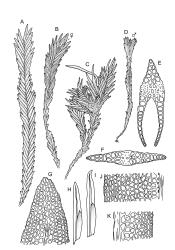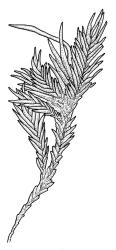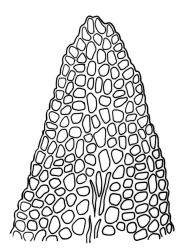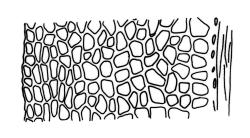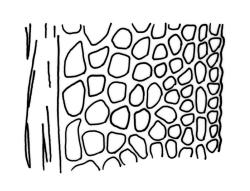Plants 6–15 mm, black except for green shoot tips, aquatic, in dense smooth mats or erect tufts. Stems branched below, with rhizoids copious at shoot base and sparse in leaf axils. Leaves in (15–)20–35(–40) pairs, overlapping at mid stem, all but the youngest usually heavily encrusted with periphyton and with apices eroded, patent, plane and rigid when moist, unaltered when dry, linear, 1.25–2.0 × 0.2–0.3 mm; apex acute to obtuse, occasionally asymmetric, apical and dorsal laminae pluristratose except for several unistratose cell rows at the margin, vaginant laminae unistratose or occasionally pluristratose adjacent to the costa, ½ leaf length, partially closed; dorsal lamina ending at leaf insertion or shortly decurrent, tapered to its base; margins crenulate; cells of apical and dorsal laminae irregular, smooth, non-bulging, thick-walled, gradually increasing in size from margin to costa, (8–)11–13(–15) × (8–)11–13(–15) µm. Costa failing (5–)6–8(–11) cells below leaf apex, bryoides-type in cross-section.
Autoicous? Perichaetia terminal on main stems or axillary branches; perichaetial leaves little differentiated from vegetative. Perigonia terminal on main stems. Calyptra smooth, mitrate. Mature capsules not seen in N.Z. material, exothecial cells in c. 50 columns (in Australian material). Peristome modified-scariosus-type (in Australian material).
Wilson 1859, pl. 171, fig. 7; Beever 1995, fig. 1; Beever et al. 2002, p. 60, figs 1–6; Stone & Catcheside 2012.
Fissidens strictus is cited as a member of subgen. Pachyfissidens sect. Pachyfissidens in the infrageneric classification of Suzuki & Iwatsuki (2007), but the modified scariosus-type peristome is anomalous there. Appropriate placement of F. strictus in the classification of Pursell & Bruggeman-Nannenga (2004) would appear to be subgen. Aloma, on account of its bryoides-type costa, modified scariosus-type peristome, smooth lamina cells and unbordered laminae. The number of columns of exothecial cells (c. 50) is, however, at odds with the <40 given for subgen. Aloma, but other exceptions are noted for this character by those authors.
Fissidens strictus may be distinguished from all other N.Z. members of the genus by the overall appearance of its shoots: the small, dark, narrowly linear leaves are held stiffly erect when either moist or dry. The complete lack of any leaf border is another diagnostic character.
NI: N Auckland; A.
Australasian. Tasmania*, mainland Australia*. A published record from Nepal (Pradhan & Joshi 2006) is strongly doubted.
On rock, firmly attached, submerged, or in the splash zone, of fast-flowing oligotrophic streams in indigenous forest. Fissidens strictus has been recorded growing with other aquatic mosses: F. integerrimus, F. rigidulus var. rigidulus, Sematophyllum uncinatum, Tridontium tasmanicum, and with the liverwort Schistochila nitidissima.
The species is apparently rare in N.Z., being known from only four sites; three sites are in the northern North I. (north of lat. 37° 00' S), and the fourth in the Auckland Is (at latitude 50° 49' S). The lack of any records from the mid latitudes of N.Z. is puzzling; in Australia it occurs in Victoria and Tasmania at comparable latitudes. It is considered "rare" in Australia by Scott & Stone (1976, p. 88).
The few records range in altitude from sea level (Auckland Is), to 320 m (Waitakere Ranges, N Auckland L.D.).
The species is classified as "Naturally Uncommon" in the N.Z. Threat Classification System (Glenny et al. 2011).
An account of the species in N.Z. was given by Beever (1995).




